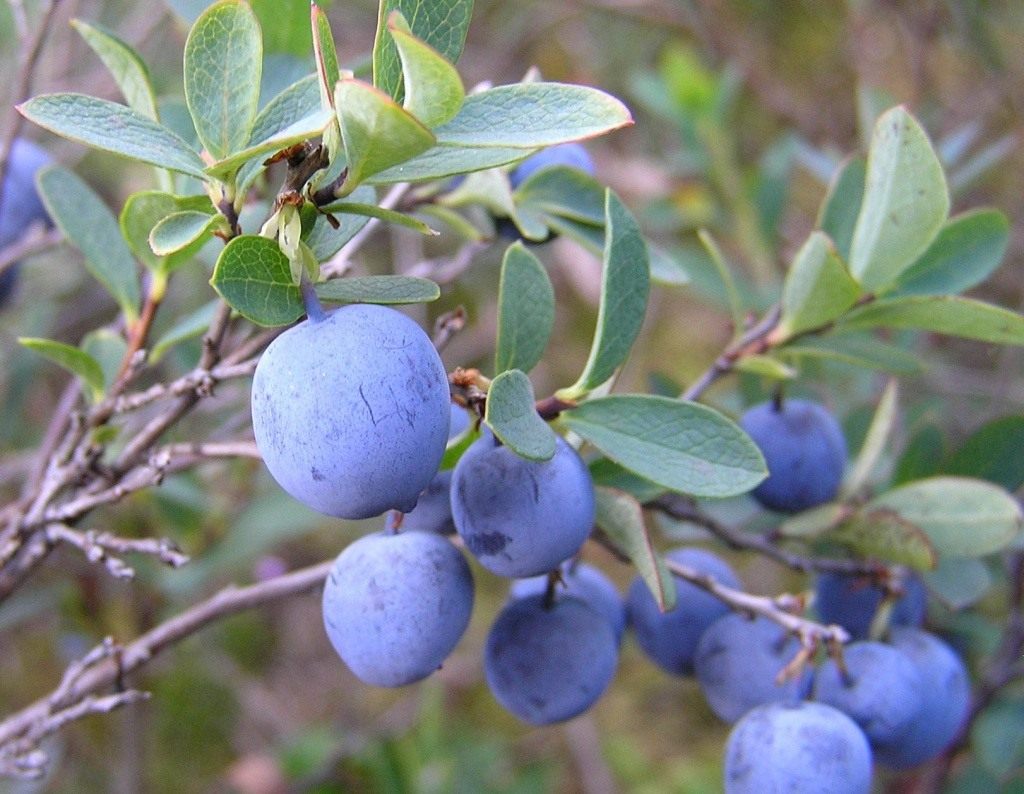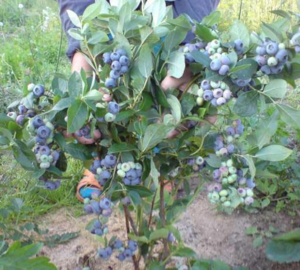 Starting your own business can be a good additional income for anyone, but which industry has the least competitors and what is the best thing to do? Growing blueberries is a great solution to grow your business with minimal investment. Blueberries are one of the most expensive berries, which are purchased in large quantities by confectionery and pharmaceutical companies. Surprisingly, even with the constant growth in the production of this berry, the market demand still remains unsatisfied.
Starting your own business can be a good additional income for anyone, but which industry has the least competitors and what is the best thing to do? Growing blueberries is a great solution to grow your business with minimal investment. Blueberries are one of the most expensive berries, which are purchased in large quantities by confectionery and pharmaceutical companies. Surprisingly, even with the constant growth in the production of this berry, the market demand still remains unsatisfied.
Blueberries can be used for more than just a business building vehicle. People grow it just for themselves as a food product or preparation of traditional medicine.
Content
Blueberry features
Blueberries have some of the characteristics that make them so rare on the market. You can grow this plant only on acidic soils, which have a reaction of pH 3.5 - 5.0. In addition, the root system can be over 30 cm long.
Such features lead to the fact that it is quite difficult to grow berries on your own soil, even if you find a certain type of soil in a swampy or forest area. The main reason for the death of blueberries when planted on ordinary soil is the absence of the saprophytic fungus, which is the main component of the berry's nutrition. If you transfer the soil from a forest or swampy area, then when the soil falls off, all the mushrooms remain in their native place. As a result, you can only get disappointment from planting blueberries in an unprepared place, where there are no saprophytic mushrooms.
A way out of this situation can be found by purchasing special varieties of berries that are capable of sprouting in garden plots. Special varieties of blueberries are obtained through modern breeding in nurseries. Growing in such premises helps to obtain biennial seedlings of excellent quality and adapted to grow in garden soil. It is important to note that seedlings are sold directly with a lump of soil on the root system, so that the plant quickly takes root in a new place.
Varieties and characteristics of blueberries
When choosing blueberry varieties for cultivation in the garden, the climatic conditions must first be taken into account. Many species simply cannot take root in the northern regions, and some late-ripening varieties do not take root even in the Moscow region. In general, there are about 20 varieties of blueberries that are suitable for growing in garden plots, but not all of them are suitable for the climate in the Moscow region. Among the suitable specimens related to early and mid-season varieties, we can distinguish such as:
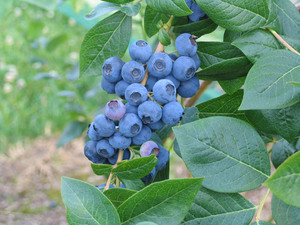 bluecrop;
bluecrop;- Blue Ray;
- erley blue;
- spartan;
- duke;
- darrow;
- rancocas.
Bluecrop cultivar
One of the varieties of blueberry varieties is Bluecrop, which belongs to the mid-season species.This type of berry is one of the most valuable today due to its standard characteristics for this plant. The bush has a height when fully ripe no more than 1.9 m, all shoots are directed upwards, and the form usually acquires a free appearance without pruning.
The berries can reach a size of about 16 mm, have a flattened shape, but the main feature is a bright and rich taste. In addition, the fruits are quite easy to pick due to the fact that all the berries are collected in a brush. This variety is very resistant to a changeable climate, which is quite often manifested in the Moscow region.
Spartan variety
Features of the Spartan variety are in the structure of the shrub, which has a straight shape. The berries are predominantly round in shape with a size not exceeding 20 mm. The fruits are pleasant to the taste and have a strong aroma. The yield from one bush can reach 6 kg, but on waterlogged soils, the number of berries is significantly reduced.
Blue Ray variety
Blue Ray bushes have powerful and straight shape... Berries exceed 20 mm in size. The fruits of this variety are famous for their aftertaste and strong aroma, which is especially popular in the confectionery industry. This type of shrub is the most resistant to cold climates and therefore excellent for growing in the Moscow region.
Features of growing blueberries
Even for growing garden blueberries, you have to prepare the site. All recommendations are mainly dictated by the needs of this plant. The problem is that, even knowing all the basic features of growing, it is quite difficult to do this on a small plot. In addition, it will also be necessary to prepare a special substrate, which will be the basis for ordinary garden or vegetable soil and will become the main food element for shrubs.
Seat selection basics
The main thing when growing blueberries is to understand at the very beginning that the plant is unpretentious in terms of its properties, but this rule does not apply to the choice of soil. Choosing a suitable place is the most important rule, which ultimately will determine the final result.
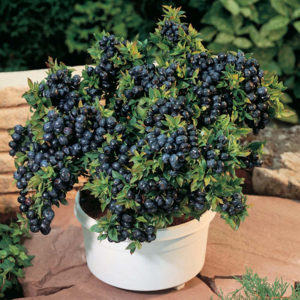 When choosing a soil, you need to pay attention to its acidity, which should be pH 3.5 - 5.0. The plant is able to thrive normally at a pH of 5.5. Higher soil acidity values will lead to slow growth of blueberries and their further death.
When choosing a soil, you need to pay attention to its acidity, which should be pH 3.5 - 5.0. The plant is able to thrive normally at a pH of 5.5. Higher soil acidity values will lead to slow growth of blueberries and their further death.- The root system of blueberry bushes is located on the surface of the soil, so the soil must necessarily have good air and moisture permeability. Acid peat soils, some varieties of sand, as well as sandy loam and soil from pine forests have the best permeability. Loams and clay soils too dense for favorable root growth. In such an environment, blueberry seedlings will simply die.
- For high-quality ripening of berries and the favorable growth of the shrub, you need a sufficient amount of sunlight.
- When choosing a place for planting, it is necessary to take into account the height of the shrubs, which can reach 2 m, which means that during frosty winds the plant will die or receive significant damage. The place is chosen on a windless site, or a kind of protective fence should be built.
- Moist soil is one of the main requirements for high-quality shrub growth. Blueberries grow in swamps, so they are used to a lot of moisture. Watering should be done at least 2 times a day, but the root system does not like liquid stagnation. This is why it is important to find soil with high moisture permeability.
Planting blueberry bushes
Planting blueberries has many features. It is prohibited to use methods that are suitable for planting other types of fruit plants or berries. In this case, just digging a hole, planting a plant and covering it with earth will not work. For blueberries you need to prepare acidic soil in advanceand also follow the recommendations for creating special conditions.
If the soil has an acidic composition and high moisture permeability, then you can start planting. For areas where groundwater occurs at a depth of 60–80 cm, the type of planting is suitable, which is associated with the creation of special wells or trenches.
Prepared trenches are filled with acidic soil and only then blueberries are planted, but this method is not suitable in cases where the soil has a clay structure. The thing is that water in clay soil will simply linger for a long time, which means that the root system will not be able to take root in such conditions. In this case, the planting method is suitable, where you need to create high ridges or beds.
When planting blueberries, it is important to pay attention to the distance between the plants. Between the bushes usually leave a distance of 1 m, and between rows 1.5 m. Such parameters were chosen in accordance with the shape of the shrubs themselves, which can grow to large sizes, and the branches usually lie on the soil surface.
Planting blueberries in special wells
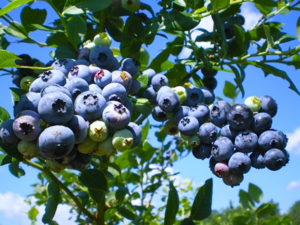 Preparation of a well begins with digging a hole or trench, which should have a depth of no more than 40 cm and a width of 0.6 to 1.5 m. The width is chosen depending on the structure of the soil.
Preparation of a well begins with digging a hole or trench, which should have a depth of no more than 40 cm and a width of 0.6 to 1.5 m. The width is chosen depending on the structure of the soil.
- For sandy loam or other soils with high permeability, a trench width of 0.6–0.8 m is suitable.
- For heavy clay and other soils with a similar structure, the width should be 1.2–1.5 m.
Into prepared pits fall asleep a pre-prepared substrate... Sphagnum peat, some river sand, coniferous sawdust or needles may be suitable here. In some cases, even coniferous humus, cones, transitional peat or ground sphagnum moss are added to the trench. It is important to remember that it is prohibited to add fertilizers habitual for growing other plants to the soil. Compost, ash and manure negatively affect the blueberry root system.
The next step is to soak the root system along with the clod. The seedlings are left in water for 30 minutes, and then they begin to be planted in holes. After burying the seedlings, the soil around the stem is compacted and watered again.
Planting blueberries on a comb
To create a ridge, you need to dig out soil 10 cm deep, and use it to make an impromptu trench on the soil surface. In the middle of the trench add a special substrateas in the case of planting blueberries in wells. Saplings are planted at the very top of the ridge.
Care and harvest
The beneficial growth of blueberries is about proper care and good and timely watering. It is especially important to monitor watering during the period when bud formation and fruiting begins. The top layer of soil, which reaches 20 cm, should always be moist, although the blueberries themselves do not need as much moisture as beets or carrots.
For good percolation of moisture into the soil, you first need to mulch it with hay or needles. This method will help not only to retain a sufficient amount of moisture, but also reduce the temperature during dry periods... Feeding of blueberries is carried out using mineral or organic fertilizers in the form of coniferous humus, needles and sawdust. Using manure or compost is strictly prohibited.
Blueberries ripen in 2–3 months. You need to collect the fruits as they ripen, while the berries can be on the bushes for no more than 10 days, and then they simply fall off. Harvesting is carried out 3-6 times per season, depending on the plant variety.
Fighting disease
Even the best and most resistant blueberry varieties are susceptible to disease. Shrubs can be affected by fungal, bacterial and even viral diseases. The most common diseases are:
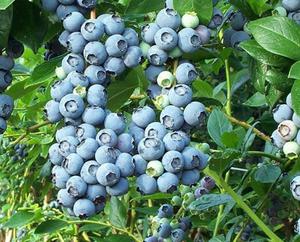 gray rot;
gray rot;- phomopsis wilting;
- stem cancer;
- late blight;
- monilial burn.
To fight disease usually use fungicides... It is recommended to start spraying with drugs immediately after spring pruning in order to prevent diseases from forming.
It makes no sense to treat shrubs from pests. Only some species of insects can eat blueberries, which can be easily collected by hand without using chemicals.
Pruning shrubs in spring
 The first blueberry pruning is done only when the plant will reach 2-4 years of age... The first pruning is carried out to form a strong skeleton of the shrub, so you need to remove all the branches that have fruit buds.
The first blueberry pruning is done only when the plant will reach 2-4 years of age... The first pruning is carried out to form a strong skeleton of the shrub, so you need to remove all the branches that have fruit buds.
The second pruning occurs when the plant is 5-6 years old. At this time, old and sick branches are cut off, as well as branches that lie on the ground.
It is best to start pruning in early spring, when the first buds of the shrubs have not yet appeared. In autumn pruning is required with rare exceptionsif a large number of dry branches appeared on the shrubs after the summer period.
Conclusion
The best blueberry varieties for the Moscow region can be found in almost any experienced breeder, but this will still not be enough. Only the correct planting, choice of location, caring for shrubs will contribute to the favorable growth of the plant. To obtain high-quality berry fruits, it is imperative to use all the rules and recommendations.


